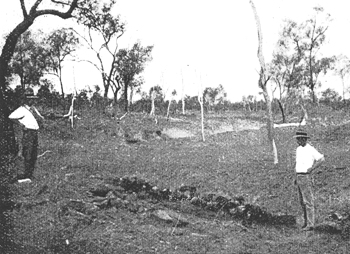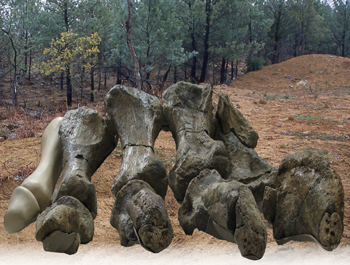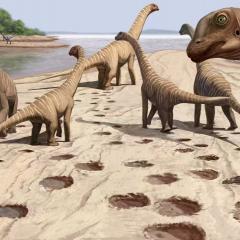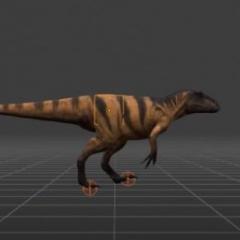
A fews years old now, but worth revisiting in light of our new research...
Research by palaeontologists from The University of Queensland is revealing exciting new insights into one of Australia’s most important dinosaur fossils.
Rhoetosaurus brownei, a sauropod from the Middle Jurassic Period, around 165 million years ago, was the country’s first named dinosaur. Estimated to have been approximately 18 m long and weighed as much 20 tonnes, it was named in 1926 by Queensland Museum Director Heber Longman.
“Rhoetosaurus is the most complete pre-Cretaceous dinosaur yet discovered in Australia. It therefore provides a valuable insight into the nature of our continent’s dinosaur fauna prior to the fragmentation of Gondwana,” said Jay Nair, a PhD student from the School of Biological Sciences, and lead author on the new study published in Journal of Vertebrate Paleontology.
The first fossils of Rhoetosaurus were found in 1924 by a team of stockmen, mustering horses on a station approximately 50 km north of Roma, south-western Queensland. When the stockman first stumbled across the gigantic bones, they assumed that they were the remains of an escaped circus elephant.
“It didn’t matter that there hadn’t been a circus go through Roma for some time, let alone one with elephants. This was only the fourth time that dinosaur fossils had been found in Australia, and all previous discoveries had been of much smaller animals. It’s not surprising that no one initially recognised the bones for what they were, at least until Longman got to see them” co-author of the study Dr Steve Salisbury said.
The original material, a series of weathered vertebrae and fragments of the hip, was found on the bank of a shallow gully. Following Longman's suggestion that there were likely to be more bones, teams from the Queensland Museum and The University of Queensland returned to the site in 1975, later recovering an almost complete right lower hind limb.
“The sum of material that has been collected over the years forms a significant portion of a single skeleton,” Mr Nair said.
Although Rhoetosaurus has been in the Queensland Museum for several decades, it is only recently that any new research on it has been undertaken.

“Our new study focuses on the lower hind limb,” Mr Nair said.
“This part of the skeleton of Rhoetosaurus is very informative, and highlights what a distinctive sauropod it was. Our study indicates that Rhoetosaurus was quite an archaic sauropod, only distantly related to the better known titanosauriform sauropods from younger rocks in Queensland, such as Wintonotitan andDiamantinasaurus,” Mr Nair said.
“For instance, Rhoetosaurus retains four clawed toes on its foot, unlike the majority of younger, more advanced sauropods, which have three.”
“When we included new data from the hind limb to test how Rhoetosaurus might have been related to other sauropods, we saw no evidence for a close relationship between it and Jurassic sauropods from eastern Asia, as was initially thought to be the case,” Mr Nair said.
“As occurs with many other Australian dinosaurs, particularly those from the Cretaceous Period, we suspect that the closest relatives of Rhoetosaurus are likely to be found among contemporaneous sauropods from other Gondwanan landmasses,” Dr Salisbury explained.
The team are now looking more closely at other parts of the skeleton of Rhoetosaurus, and Mr Nair is working with staff and volunteers at the Queensland Museum with the ongoing preparation of the original bones. It is anticipated that this work is likely to reveal more information on the anatomy of this important dinosaur.
“It’s great to see this new research being conducted on Rhoetosaurus,” said Dr Andrew Rozefelds, Head of Geosciences at the Queensland Museum.
“It highlights the fact that as our knowledge of dinosaurs increases, so too does the need to revisit museum collections to reexamine old discoveries. AlthoughRhoetosaurus was the first dinosaur to go into our collections, it’s still providing us with exciting new clues into Queensland’s unique prehistory.”
A new exhibit, Giants of the Past, featuring some of the Rhoetosaurus bones, is now on at the Queensland Museum, South Bank. When the current research is completed the museum intends to put the remainder of the skeleton on display.
UQ Press Release
Media: Jay Nair (+ 61 447 721 012, jayraptor@gmail.com); Dr Steve Salisbury (+61 7 3365 8548 or + 61 407 788 660, s.salisbury@uq.edu.au); or Allison Rock (+61 7 3346 0561, a.rock1@uq.edu.au).
Nair, J.P. and Salisbury, S.W. 2012. New anatomical information on Rhoetosaurus brownei Longman, 1926, a gravisaurian sauropodomorph dinosaur from the Middle Jurassic of Queensland, Australia. Journal of Vertebrate Paleontology 32(2), 369–394. pdf + SI, MorphoBank



